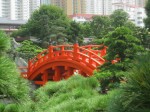 One of the outstanding sites in Hong Kong is Nan Lian Garden. It offers visitors an opportunity to leave the city behind and experience a classical Tang-style garden with rocks, water, pavilions, and naturalistically treated plants. A Buddhist nunnery lies adjacent to the garden and is well worth a visit. Located in Diamond Hill in the Kowloon area of Hong Kong, the garden can easily and inexpensively be reached by subway and is free of charge.
One of the outstanding sites in Hong Kong is Nan Lian Garden. It offers visitors an opportunity to leave the city behind and experience a classical Tang-style garden with rocks, water, pavilions, and naturalistically treated plants. A Buddhist nunnery lies adjacent to the garden and is well worth a visit. Located in Diamond Hill in the Kowloon area of Hong Kong, the garden can easily and inexpensively be reached by subway and is free of charge.
The garden is fairly large (35,000 square meters) and should be savored slowly so plan to spend about 3-4 hours there, perhaps more if you decide to have lunch at the vegetarian restaurant located within the garden.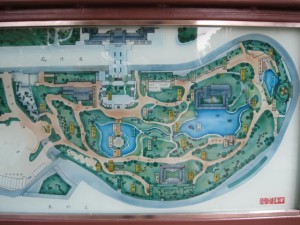
The garden was laid out so that the noise, pollution, and energy of the city around it was shut out so the visitors could enjoy peace and quiet. The approach to the garden led us past large noise barriers.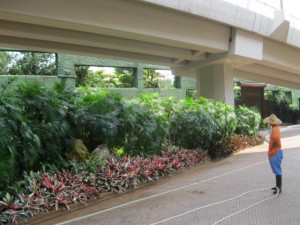
This broad road to the garden was beautifully planted with foliage plants on both sides.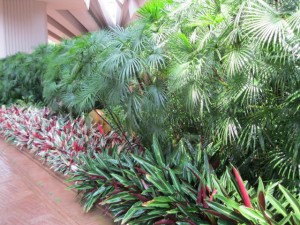
A large screen stood in front of the entrance gate.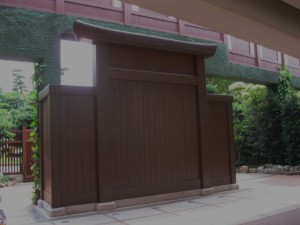
The entrance was marked by the large and imposing Black lintel Gate.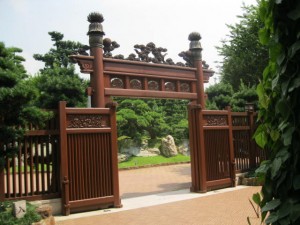
The walkway winds through the garden and guides the visitors in a one way path thus reducing the number of people collecting in a given area.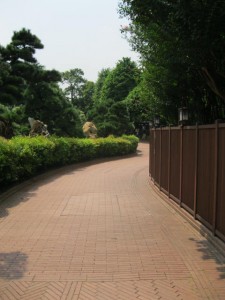
Many hills and mounds have been created to increase the tranquility by reducing noise and pollution.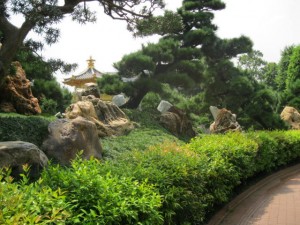
Stepping stones create a feeling of intimacy and privacy and promise to reveal a new and interesting experience.
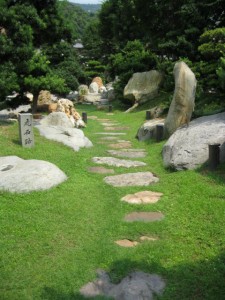
One of the first pavilions we came to was the Chinese Timber Architecture Gallery where you can see models of structures built without nails, a technique used to build the Buddhist temple associated with the garden. (No photography allowed inside)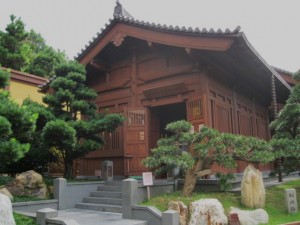
The garden has two large ponds one of which has a large planting of lotuses, giving it the name “Lotus Pond”. On the far right you can see Spring Hill with its waterfall.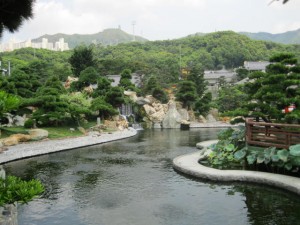
One side of the pond has a pavement of closely laid stones.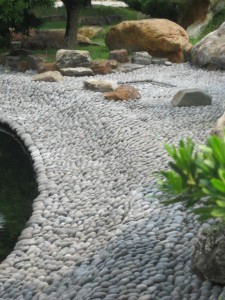
The Perfection Pavilion sites in the middle of the pond and is connected to the land by two Zi Wu Bridges, one on either side of the pavilion.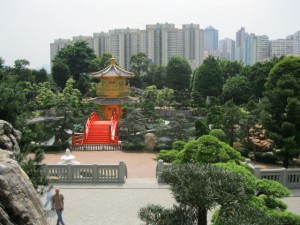
Rocks, water and unusual trees create the backdrop for the city skyline behind them.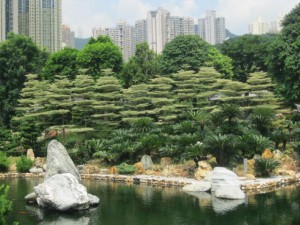
The second pond, Blue Pond, is stocked with koi. The Pavillion Bridge provides a place to view the koi as well as the reflections of the trees, rocks, and pavilions around it.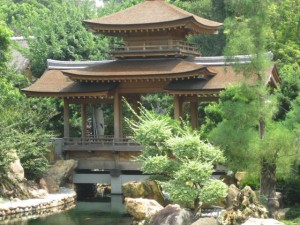
The Pavilion Bridge links the Blue Pond to another water feature, the Silver Stand waterfall’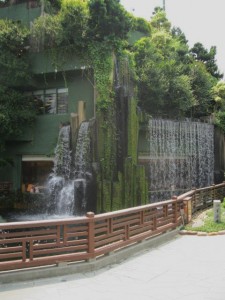
Long Men Lou, the vegetarian restaurant operated by the Buddhist nunnery, is located so that diners may look out through the waterfall as their enjoy their meal.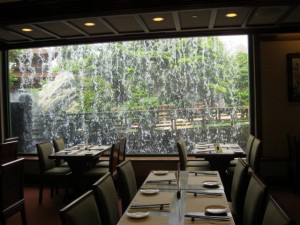
A mill sits on the Blue Pond near the waterfall.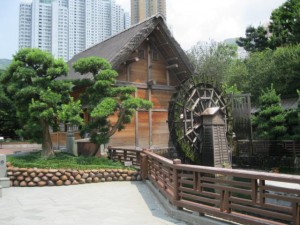
The building known as Xiang hai Xuan, a lovely place to relax in the shade and enjoy the scenery. The main room in the building is rented out for activities such as art exhibits, musical performances, and seminars.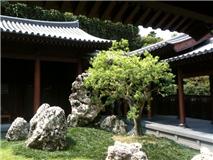
The name Xiang hai Xuan means “house embracing sea of fragrance’ and refers to the Hill of Fragrance located on one side which is heavily planted with orange jasmine, osmanthus, and lilies.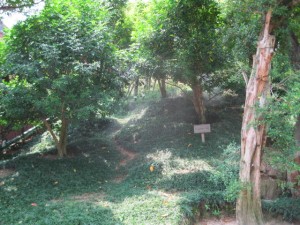
Pine Hill features black pine planted on a hillside with rocks arranged to complement the plantings.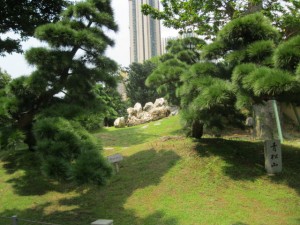
The Banyan Grove offered shade and a close look at these interesting trees. They have special significance to Buddhists because Buddha is believed to have achieved enlightenment while meditating under a Banyan tree.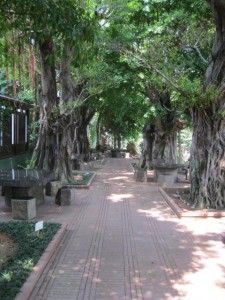
Banyon trees, a kind of fig tree, develops a complex aerial root system that gives it the common name of “strangler fig.”
The garden includes many some very beautiful trees including Chinese elm,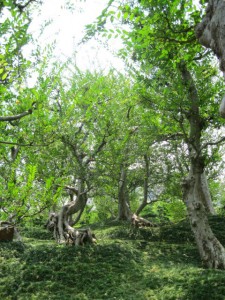
And Buddhist Pine (Podocurpus macrophyllus), seen here being pruned.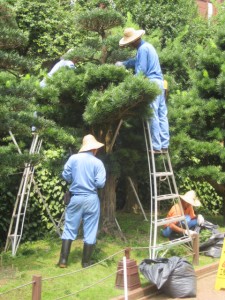
Dwarf mundo grass is a common ground cover.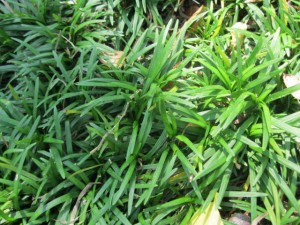
The bougainvillea creates a virtual fairy land when it blooms.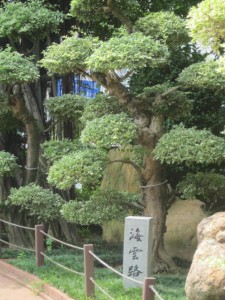
One area, the Rock Cloud, is dominated by rocks surrounded by a cloud of mist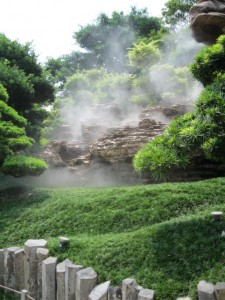
When you see this planting you are at the entrance to the causeway that takes you to the Buddhist nunnery.
The courtyard of the nunnery provides a good overview of the garden you just left as well as a grand display of pools with water lilies.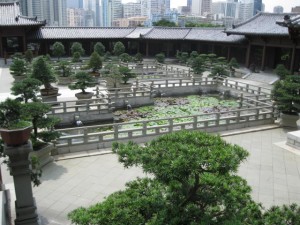
The water lilies were in bloom when we visited in September, and provided a soft touch to the strong lines of the courtyard and pool.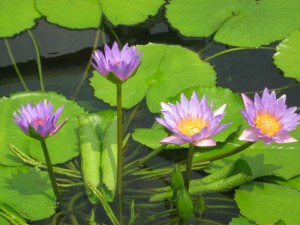
The Chin Lin nunnery worked with the Hong Kong Cultural Services Department to develop the garden which is based on the Jiangshouju Gardens and Ponds in Shanxi, China. The choice of a classical Tang-style garden was made in order to signify the continuity of Chinese culture and the cultural unification that resulted from the unification of Hong Kong and China in 1997. In addition, the Chi Lin nunnery was in the Tang style and it had extensive experience with the arts of that period. The nunnery has the sole responsibility for the design, planting, construction and maintenance of the garden. The government provided the funds for the infrastructure and the nunnery donated funds for the other costs. Together they have created a great treasure.

I was thinking about you after I sent the email and went to look at your garden journal. I’m glad I did, I love seeing the pictures and reading about the garden.
Nancy,
Gardens make my spirit soar and give me hope that tomorrow will be a better day.
Karen
Karen,
.
You mention the large screen at the gate.
I must confess I don’t remember it, but
often screens at Chinese gates are to
keep bad spirits from entering. Bad spirits
can only move in a straight line, it is
said, and can’t turn corners. So if you
put a screen in front of a gate that is
slightly wider than the gate, bad spirits
can’t enter.
.
An ancient Chinese language professor of
mine once explained his own take on
spirits. He said: “I no longer believe
in spirits, but I’m still afraid of them.”
.
Ashley,
Thanks for the explanation of the screen at Chinese gardens; we noticed them at several gardens. I love the story about the Chinese professor and spirits because I don’t step on cracks or walk under ladders if I can avoid it.
Karen